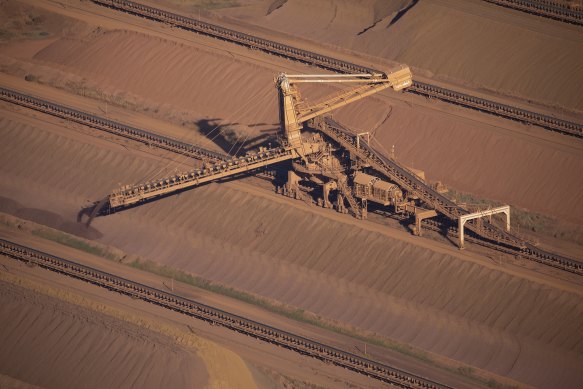By Nick Toscano
The price of iron ore, Australia’s biggest export, has continued to plunge as top customer China steps up moves to cut its steel output and reduce carbon emissions for the third straight month.
After hitting a record-breaking $US230 a tonne in May, the key steel-making material has had its value slashed in half and is now trading below $US110 a tonne, hammering the share prices of the ASX-listed mining heavyweights BHP, Rio Tinto and Fortescue.

Iron ore is Australia’s biggest export, raking in more than $100 billion a year.Credit: Krystle Wright
Investment bank UBS on Friday lowered its iron ore price forecasts out to 2023 by about 10 per cent amid a slowdown in property activity in China and expectations the seaborne market would soon be oversupplied.
“The correction in iron ore prices has played out faster than expected,” analyst Lachlan Shaw said.
“We expect the iron ore market to swing into surplus in the second half of 2021, prices to fall below $US100 a tonne over the next few months, before averaging $US89 a tonne in calendar year 2022.”
UBS put a “sell” rating on the Andrew Forrest-backed iron ore miner Fortescue Metals Group, while reiterating its “sell” rating on Rio Tinto and neutral rating on BHP.
Fortescue’s share price slumped 11 per cent by early afternoon on Friday, while BHP and Rio shares were down 3.25 per cent and 4 per cent, respectively.
Iron ore has experienced a stunning rally for the past 12 months, underpinned by an aggressive infrastructure-focused building blitz in China, which fuelled enormous demand for steel at the same time as drawn-out supply disruptions dragged on iron ore mines in Brazil.
The boom delivered huge profits and bumper dividends across all three Australian mining giants, and helped bolster Australia’s finances during the depths of the COVID-19 crisis. In 2020, iron ore accounted for $120 billion in export earnings – the first of any Australian export to top the $100 billion mark.
Australia is the world’s largest iron ore producer and the biggest shipper of the commodity to China, which accounts for about 70 per cent of global demand.
‘The correction in iron ore prices has played out faster than expected.’
UBS analyst Lachlan Shaw
However, the material is under mounting pressure as Beijing deepens production cuts across its steel mills to reduce emissions from one of its worst-polluting industries, Commonwealth Bank mining analyst Vivek Dhar said.
“China is looking to cap China’s crude steel output in 2021 at 2020 levels to reduce emissions,” he said. ” That implies an approximately 12 per cent year-on-year contraction in China’s steel output from September to December.”
Chinese steel output cuts may accelerate later this month or October, Mr Dhar added, as a number of provinces fell behind their reduction targets. “Steel mills in Jiangsu, Shandong and Liaoning – the largest steel producing provinces after Hebei – have gradually launched steel output cuts since the beginning of September,” he said.
It comes as China has been showing growing appetite for another one of Australia’s most valuable commodity exports, liquefied natural gas (LNG).
Despite worsening trade tensions between Beijing and Canberra that have affected the flow of other goods, nine additional cargoes of LNG were delivered from Australia to China last month, according to energy consultancy EnergyQuest.
“In August, 41 cargoes were delivered to China after delivering 32 in July and 36 in August 2020,” EnergyQuest chief executive Graeme Bethune said.
China, the world’s biggest consumer of raw materials, has been imposing tariffs and import restrictions targeting Australian shipments of a range of products including wine, barley and beef, and has an unofficial ban on all Australian coal deliveries.
There are concerns Australia’s new security pact with the United States and United Kingdom may add to the diplomatic fallout and the risk of it continuing to spill over into trade.
The Market Recap newsletter is a wrap of the day’s trading. Get it each weekday afternoon.